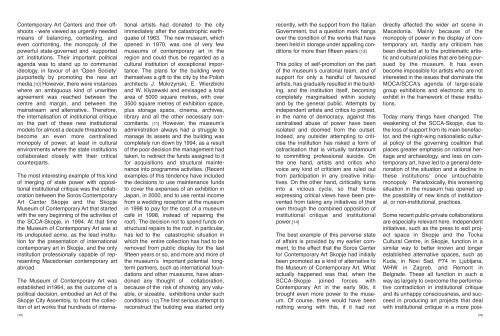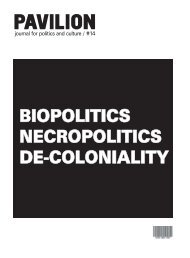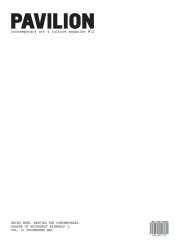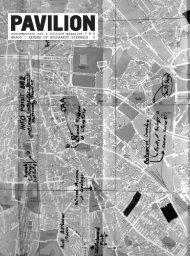Download pdf version of issue no. 16 (4 Mb) - Pavilion
Download pdf version of issue no. 16 (4 Mb) - Pavilion
Download pdf version of issue no. 16 (4 Mb) - Pavilion
You also want an ePaper? Increase the reach of your titles
YUMPU automatically turns print PDFs into web optimized ePapers that Google loves.
Contemporary Art Centers and their <strong>of</strong>fshoots<br />
- were viewed as urgently needed<br />
means <strong>of</strong> balancing, contesting, and<br />
even confronting, the mo<strong>no</strong>poly <strong>of</strong> the<br />
powerful state-governed and -supported<br />
art institutions. Their important political<br />
agenda was to stand up to communist<br />
ideology, in favour <strong>of</strong> an ‘Open Society’<br />
purportedly by promoting the new art<br />
media.[10] However, there were instances<br />
where an ambiguous kind <strong>of</strong> unwritten<br />
agreement was reached between the<br />
centre and margin, and between the<br />
mainstream and alternative.. Therefore,<br />
the internalisation <strong>of</strong> institutional critique<br />
on the part <strong>of</strong> these new institutional<br />
models for almost a decade threatened to<br />
become an even more centralised<br />
mo<strong>no</strong>poly <strong>of</strong> power, at least in cultural<br />
environments where the state institutions<br />
collaborated closely with their critical<br />
counterparts.<br />
The most interesting example <strong>of</strong> this kind<br />
<strong>of</strong> merging <strong>of</strong> state power with oppositional<br />
institutional critique was the collaboration<br />
between the Soros Contemporary<br />
Art Center Skopje and the Skopje<br />
Museum <strong>of</strong> Contemporary Art that started<br />
with the very beginning <strong>of</strong> the activities <strong>of</strong><br />
the SCCA-Skopje, in 1994. At that time<br />
the Museum <strong>of</strong> Contemporary Art was at<br />
its undisputed acme, as the lead institution<br />
for the presentation <strong>of</strong> international<br />
contemporary art in Skopje, and the only<br />
institution pr<strong>of</strong>essionally capable <strong>of</strong> representing<br />
Macedonian contemporary art<br />
abroad.<br />
The Museum <strong>of</strong> Contemporary Art was<br />
established in1964, as the outcome <strong>of</strong> a<br />
political decision, embodied an Act <strong>of</strong> the<br />
Skopje City Assembly, to host the collection<br />
<strong>of</strong> art works that hundreds <strong>of</strong> interna-<br />
[38]<br />
tional artists had donated to the city<br />
immediately after the catastrophic earthquake<br />
<strong>of</strong> 1963. The new museum, which<br />
opened in 1970, was one <strong>of</strong> very few<br />
museums <strong>of</strong> contemporary art in the<br />
region and could thus be regarded as a<br />
cultural institution <strong>of</strong> exceptional importance.<br />
The plans for the building were<br />
themselves a gift to the city by the Polish<br />
architects J. Mokrzynski, E. Wierzbicki<br />
and W. Klyzewski and envisaged a total<br />
area <strong>of</strong> 5000 square metres, with over<br />
3500 square metres <strong>of</strong> exhibition space,<br />
plus storage space, cinema, archives,<br />
library and all the other necessary concomitants.<br />
[11] However, the museum’s<br />
administration always had a struggle to<br />
manage its assets and the building was<br />
completely run down by 1994, as a result<br />
<strong>of</strong> the poor decision the management had<br />
taken, to redirect the funds assigned to it<br />
for acquisitions and structural maintenance<br />
into programme activities. (Recent<br />
examples <strong>of</strong> this tendency have included<br />
the decisions to use maintenance funds<br />
to cover the expenses <strong>of</strong> an exhibition in<br />
Japan, in 2000, and to use rental income<br />
from a wedding reception at the museum<br />
in 1998 to pay for the cost <strong>of</strong> a museum<br />
café in 1998, instead <strong>of</strong> repairing the<br />
ro<strong>of</strong>). The decision <strong>no</strong>t to spend funds on<br />
structural repairs to the ro<strong>of</strong>, in particular,<br />
has led to the catastrophic situation in<br />
which the entire collection has had to be<br />
removed from public display for the last<br />
fifteen years or so, and more and more <strong>of</strong><br />
the museum’s important potential longterm<br />
partners, such as international foundations<br />
and other museums, have abandoned<br />
any thought <strong>of</strong> collaboration,<br />
because <strong>of</strong> the risk <strong>of</strong> showing any valuable,<br />
or sizeable, exhibitions under such<br />
conditions. [12] The first serious attempt to<br />
reconstruct the building was started only<br />
recently, with the support from the Italian<br />
Government, but a question mark hangs<br />
over the condition <strong>of</strong> the works that have<br />
been held in storage under appalling conditions<br />
for more than fifteen years [13]<br />
This policy <strong>of</strong> self-promotion on the part<br />
<strong>of</strong> the museum’s curatorial team, and <strong>of</strong><br />
support for only a handful <strong>of</strong> favoured<br />
artists, has gradually resulted in the building,<br />
and the institution itself, becoming<br />
completely marginalised within society<br />
and by the general public. Attempts by<br />
independent artists and critics to protest,<br />
in the name <strong>of</strong> democracy, against this<br />
centralised abuse <strong>of</strong> power have been<br />
isolated and doomed from the outset.<br />
Indeed, any outsider attempting to criticise<br />
the institution has risked a form <strong>of</strong><br />
ostracisation that is virtually tantamount<br />
to committing pr<strong>of</strong>essional suicide. On<br />
the one hand, artists and critics who<br />
voice any kind <strong>of</strong> criticism are ruled out<br />
from participation in any creative initiatives.<br />
On the other hand, ciriticality turns<br />
into a vicious cycle, so that those<br />
expressing critical views have been prevented<br />
from taking any initiatives <strong>of</strong> their<br />
own through the combined opposition <strong>of</strong><br />
institutional critique and institutional<br />
power.[14]<br />
The best example <strong>of</strong> this perverse state<br />
<strong>of</strong> affairs is provided by my earlier comment,<br />
to the effect that the Soros Center<br />
for Contemporary Art Skopje had initially<br />
been promoted as a kind <strong>of</strong> alternative to<br />
the Museum <strong>of</strong> Contemporary Art. What<br />
actually happened was that, when the<br />
SCCA-Skopje joined forces with<br />
Contemporary Art in the early 90s, it<br />
brought even more power to the museum.<br />
Of course, there would have been<br />
<strong>no</strong>thing wrong with this, if it had <strong>no</strong>t<br />
directly affected the wider art scene in<br />
Macedonia. Mainly because <strong>of</strong> the<br />
mo<strong>no</strong>poly <strong>of</strong> power in the display <strong>of</strong> contemporary<br />
art, hardly any criticism has<br />
been directed at to the problematic artistic<br />
and cultural policies that are being pursued<br />
by the museum. It has even<br />
become impossible for artists who are <strong>no</strong>t<br />
interested in the <strong>issue</strong>s that dominate the<br />
MOCA/SCCA’s agenda <strong>of</strong> large-scale<br />
group exhibitions and electronic arts to<br />
exhibit in the framework <strong>of</strong> these institutions.<br />
Today many things have changed. The<br />
weakening <strong>of</strong> the SCCA-Skopje, due to<br />
the loss <strong>of</strong> support from its main benefactor,<br />
and the right-wing nationalistic cultural<br />
policy <strong>of</strong> the governing coalition that<br />
places greater emphasis on national heritage<br />
and archaeology, and less on contemporary<br />
art, have led to a general deterioration<br />
<strong>of</strong> the situation and a decline in<br />
these institutions’ once untouchable<br />
mo<strong>no</strong>poly. Paradoxically, this worsening<br />
situation in the museum has opened up<br />
the possibility <strong>of</strong> new kinds <strong>of</strong> institutional,<br />
or <strong>no</strong>n-institutional, practices.<br />
Some recent public-private collaborations<br />
are especially relevant here. Independent<br />
initiatives, such as the press to exit project<br />
space in Skopje and the Tocka<br />
Cultural Centre, in Skopje, function in a<br />
similar way to better k<strong>no</strong>wn and longer<br />
established alternative spaces, such as<br />
Kuda, in Novi Sad, P74 in Ljubljana,<br />
WHW in Zagreb, and Remont in<br />
Belgrade. These all function in such a<br />
way as largely to overcome the performative<br />
contradiction in institutional critique<br />
and its unhappy consciousness, and succeed<br />
in producing art projects that deal<br />
with institutional critique in a more posi-<br />
[39]








